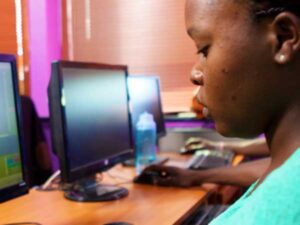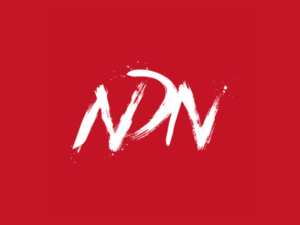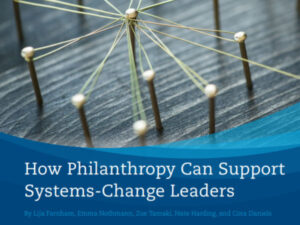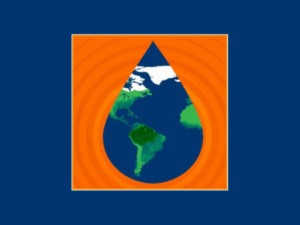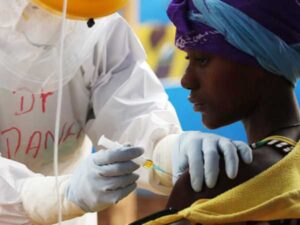Last Mile Health scales access to basic health services by supporting community health workers with hybrid learning and long-term partnerships.
Kayleigh Begley of Last Mile Health spoke with Jessica Kantor on February 23, 2023. Click here to read the full conversation with insights highlighted.
Jessica Kantor: To get started, can you describe the problem that you’re addressing and how you’re responding to it?
Kayleigh Begley: The big picture problem that Last Mile Health aims to address is that, despite incredible advancements and progress in healthcare over recent decades, nearly 2 billion people remain out of the healthcare system. This means that folks are unable to access even basic, essential health services, and this can lead to nearly 9 million preventable deaths a year from childbirth that is done at home unattended, not in a clinic or from childhood diseases like malaria, malnutrition, pneumonia, diarrhea. The scope of this problem is huge, but there’s a solution to this problem in a lot of ways. Specifically for those communities that are currently out of reach of the health system, we work to scale a professional community health worker model.
Community health workers are folks that live in rural and remote communities, and they’re trained to serve their neighbors. They can provide a set of basic services after a few months of training; testing, treating malaria, diagnosing malnutrition, connecting women with clinics for pre and antenatal care, and making sure that facility based delivery rates increase. Last Mile Health was founded in Liberia. We tested a community-based health worker model there and then, following Ebola, we worked with the government to scale that program nationally. Now we are working with four African governments and also on global advocacy initiatives to see the professional community health worker model scaled and realizing its full potential.
Jessica Kantor: How do you engage with the community to get them trained to be community workers?
Kayleigh Begley: It depends on the particular community health worker program that we’re working on. In Liberia where we’ve had the opportunity to co-design the program alongside the Liberian government, we engage local councils, local leaders to identify and recruit people from within the community that we then train and integrate into the health system. They’re supervised by a nurse who’s based at a health clinic, and they’re supplied and salaried through this national program. The identification and recruitment of individuals largely comes from local councils.
I have a little bit less insight into the specific recruiting practices in some of the other countries where we work. In Ethiopia, for example, we have a long-established program functioning since the early 2000s. The government there employs 40,000 health extension workers. I believe their model is a bit different in both how their community health workers are recruited and also how they’re deployed. I think sometimes they can end up serving at health outposts in rural and remote communities that are a bit different than their home communities.
Jessica Kantor: Once they are recruited, how do they engage with your services?
Kayleigh Begley: Again, it really depends country by country. In Liberia, we worked hand in hand with the government to design the national curriculum that’s training those health workers. We’re doing a similar thing in Sierra Leone right now where we’re helping to roll out a nationally standardized curriculum [where we] provide materials and work to facilitate training. Last Mile Health doesn’t actually conduct the training, but we’re facilitating the training, making sure that trainers are able to provide that information. We also work to track data on the outcomes of those trainings and analyze the effectiveness in terms of improved knowledge and skills.
All of that is really done with an idea of how we can best support our government partner to improve the quality of implementation to help realize the potential of this model. In Ethiopia, we recently co-designed a new learning model for continuing education for health extension workers. Traditionally, health extension workers in Ethiopia receive their initial training and then the goal is to have them do continuing education on a rotating basis on a number of different modules like reproductive, maternal and child health.
Having these in-person trainings can be really costly and that can be a barrier to actually conducting them on an ideal schedule that the government has laid out. We co-designed a hybrid learning model to reduce the cost. Folks still gather for a couple of days, but they do a lot of learning through tablets that we provide, and then they’re able to take those tablets back to their health outposts and access that information after. It is more dynamic content that was designed by local animators, it is translated into local languages, and then it can be used for continued reference rather than just a one-time training. Having designed that with the Ethiopian government, we’re now looking to scale what we did as a pilot and to apply it to other learning modules as well, like non-communicable diseases.
Jessica Kantor: Can you share a little bit more about the data tracking and how you are measuring success specifically? And also, what evidence do you have that you are currently making progress?
Kayleigh Begley: I got very excited when you mentioned data tracking because I was thinking, “I haven’t mentioned Malawi yet,” and I do want to. Malawi is the fourth key government partner that we currently have, and they have a lot of focus on data. We’re partnering with them to roll out the Integrated Community Health Information System that’s equipping community health workers with tablets where they enter patient information. It facilitates their experience, they’re able to pull up patient histories and things more easily, and then that data can be aggregated and used to inform national policy. I have a great one-minute video on that work that I can share with you afterwards, but we’ve got a really strong focus specifically in that country on use of data by and for community health workers.
We have a great monitoring and evaluation team. We do work with some academic researchers as well, and we conduct some published research, but we’re also using monitoring and evaluation to inform our own program decisions and also hopefully lead to insights for the field.
In Liberia for example, we track the outputs of the national community health worker program at scale. We’ve got 4,000 community health workers who’ve conducted over 5 million home visits and now treated nearly a million cases of childhood malaria, diarrhea, and pneumonia, and conducted more than a million malnutrition screenings. Another data point we’ve found through our work in Liberia is that CHWs are now treating nearly half of all malaria cases for children under five in the country.
With our program with the government of Ethiopia, we were able to see a 38% reduction in the cost to implement a training, but maintaining knowledge and skills gained. That’s the kind of data that we’re tracking to say, “Are these innovations, are these changes working and achieving their desired outcome?” On a larger basis as a field, us and our colleagues, the exemplars through Gates Foundation, Community Health Impact Coalition – there’s a number of organizations focused on capturing the impact of community health workers and really conveying that. In Malawi, for example, there was a recent exemplar’s article talking about how Malawi has achieved twice the rate of modern contraceptive use compared to sub-Saharan Africa more broadly.
There was a focused effort of the Malawi national government to increase access to family planning. One of the key drivers to this was the community health worker program. They equipped community health workers with contraceptives, as part of their overall basket of services, and they trained them to provide education on their use and benefits, and then they were able to make that available. So I think to summarize, we’re both tracking what’s the impact of our specific work to hopefully drive improvements in things like community health worker knowledge, but then we’re working alongside our peers to try to understand this bigger picture impact of how that can improve trends and broader outcomes in health for rural and remote populations.
Jessica Kantor: What makes your approach distinctive from others?
Kayleigh Begley: We are part of a unique movement that I think is really gaining traction, advocating for professional community health workers as an essential part of strong primary health systems. We’ve been doing that work for 15 years now, and we’ve seen incredible progress. We used to do a lot of advocating for why community health workers were important, and now we’re seeing that broadly adopted by the World Health Organization, the Global Fund, USAID. We’ve got some really powerful champions and organizations that are like, “Yes, this is essential and we’re going to integrate this into our policies and our norms.”
Within that movement, we work alongside a number of peers who are also advocating for that. I think we have a unique role to play within that movement, both in terms of our country’s government partners and our work to influence broader international funding flows. But we really achieve impact by working in coalition with others who have the same ambition.
Jessica Kantor: The organization has been doing this for 15 years, what are some insights or some teachable lessons that can be taken from the work that you guys have done that others could use?
Kayleigh Begley: I joined Last Mile Health two years ago, right around the time when the COVID vaccine came out. So I’m still relatively new to all of this, but speaking on behalf of the organization more broadly, there are a couple of lessons that we’ve learned from starting at the community level. We were functioning in one community at first, and then one district and then one county, and then nationally and now internationally. We’ve known the potential of this model of neighbors serving their neighbors, but we’ve found a number of key lessons as being essential to realizing the potential of these community health workers.
Making sure that [community health workers] are integrated into broader health systems. We call our approach, The Successes. It’s making sure that community health workers are skilled, supplied, salaried, supervised, integrated into national systems, functioning at scale. The last two assets get a little abstract, but the idea was that as individuals, community health workers aren’t going to achieve their full potential. They need to be integrated in the strong systems. And so I think that’s one insight that we found and guided our work from the community to national level.
As we began working at the national level, we realized what’s key is enabling policy that supports the development of strong programs. If you’re going to enable policy, what you really need is aligned international funding that supports the development of national prioritization and national policies and programs. Now we are focused on a new initiative alongside our government work called Africa Frontline First, that aims to increase and align funding for community health in Africa. A lot of times countries are dealing with fragmented funding, funding that comes with a lot of restrictions, funding that’s focused on specific sub-geographies or specific disease verticals. One of the lessons that we’ve seen is that if we want to see strong integrated healthcare made available to Last Mile communities, we really need to increase overall financing and align that financing so it’s less fragmented.
Jessica Kantor: You’ve already spoken a little bit about the system level change that you are working towards. So can you speak about that a little bit more?
Kayleigh Begley: Like I mentioned at the top of the call, 2 billion people are still out of reach of health services. This is unacceptable. We can change systems to achieve our collective ambitions around universal health coverage. It’s laid out in the sustainable development goals. We have a collective vision of universal health coverage, and we can achieve it by changing systems. One of the ways that we’re working to do that is through this community health worker model. This is a fundamental shift in how health services are delivered to rural and remote communities and I think we’re seeing it gain traction in other places too.
During the COVID-19 pandemic, we saw this in the US in both rural and urban areas, the power of community health workers to draw on trust in their communities and serve their communities both with basic care, but also to connect them to broader systems. Realizing the potential of professional community health workers is a fundamental shift and change in the broader health system. We need to change broader systems to realize that potential. So we need enabling policies and we need aligned financing.
Jessica Kantor: So enabling policies and funding, what else is needed from other actors or partners in order to advance the system’s policy change?
Kayleigh Begley: We have found deep collaboration to be absolutely necessary for progress. We sometimes see fragmentation of health interventions along disease verticals. So an organization is focused specifically on malaria in one or two counties of Liberia, or specifically focused on TB or reducing maternal mortality. How can we collaborate and work together to achieve progress? Collaboration has been a focus. Long-term commitments are the other thing that we’re increasingly looking to our partners for, looking to ourselves for. After 15 years in Liberia, we’ve seen a ton of progress. But we sometimes put unrealistic timelines on change work. If we’re going to sustain progress, we need to commit for the long haul together. And that’s one of our primary asks to partners and others in the field is like, “Let’s stay in this together.”
Jessica Kantor: Tying back to the past question about actionable insights, do you know of any choices that the organization made early on or even recently that just didn’t work and they learned a lesson from that others can learn from?
Kayleigh Begley: The importance of adapting and monitoring for impact, are we achieving our intended goals? You might identify a particular problem that you aim to address and what you think is the solution, and then you have to monitor how that solution is implemented to see if it actually works and if you need to pivot.
One of the ways that we saw this was around something we launched called The Community Health Academy that was developed to train community health workers around the world. We recognized that that training was needed for community health workers. We identified a gap and a problem, and we launched a product to try to address that. We were able to reach more than 30,000 learners in almost every country in the world. So on the one hand, we were achieving great impact and reach with this model. But we found that our average learner wasn’t necessarily our target learner. We have now integrated our Community Health Academy programming into our government work and are tailoring it more specifically to reach community health workers and other frontline health workers. We had a problem, we identified a solution, but then we needed to adapt that solution over time.
Jessica Kantor: What are current limitations or challenges that you face, aside from raising sufficient funding, which is a challenge that almost every social innovator faces.
Kayleigh Begley: I think for us it does come down to funding and financing. We definitely are focused on raising sufficient funds for ourselves as an organization, that’s necessary work. One of the primary challenges we face in realizing the potential of this model is the overall community health financing gap, particularly this $4 billion financing gap that we face in Africa. That’s where we have focused on increasing efforts coming out of the pandemic. How do we use this moment in global health to catalyze more funding for this solution? That is one of the limitations that we’re currently focused on addressing alongside our partners Financing Alliance for Health and Community Health Impact Coalition.
Even though we’ve seen increasing traction, and I want to celebrate it as a success that we are seeing increasing traction in the recognition of community health workers as professionals, it is absolutely still a limitation that guides the field overall. More than 80% of community health workers in Africa are unpaid, it’s volunteer labor. We’re asking for this really substantial investment of time and sacrifice on the part of a primarily female workforce that is just unacceptable. We’re seeing progress. We’re seeing more and more that professional community health workers are recognized as the goal. But I think we have a long way to go in terms of figuring out how to align the funding that makes that a reality.
Jessica Kantor: Someone that we spoke to previously mentioned that once healthcare workers, who are primarily women, do get recognized as actual work and get paid, then suddenly it turns into a male job. Is that something you are finding as well?
Kayleigh Begley: That’s exactly what we’re finding, and it’s something that we’re working to address in Liberia currently. Seventy percent of community health workers are women, and when volunteering that percentage is even higher. We worked to launch the National Community Health Assistant program in Liberia in 2016 and did an analysis that was published last year that showed only 17% of Liberia’s community health workers are female. What happened was when you started paying community health workers, it became a male dominated job.
Despite the explicit intention of the program to preferentially recruit female community health workers because of the nature of the services they’re providing, they’re giving women access to family planning, they’re providing prenatal visits, antenatal care, they’re treating young children. Women are trusted by other women so they’re actually able to sometimes achieve more health gains. We are working to make changes to the policy and the program implementation to address some of the barriers to women becoming CHWs.
Some of that relates to perception around who occupies a role, but some of them are very functional barriers in terms of literacy. Sometimes literacy rates for women in rural and remote communities are lower so [we need to] address challenges around literacy requirements. One very specific example is around the requirement for a motorbike license rather than having that be a prerequisite, can you have that be part of the training program? Some of the changes are around safety and security, asking women to travel alone between remote communities can be a challenge. Can you shift that expectation? And changing where some of the recruitment in Liberia happens and then also making more explicit guidance to local leaders and committees that there’s an expectation around the percentage of females that are nominated for the roles.
Jessica Kantor: How do you see the work evolving over the next five years?
Kayleigh Begley: We just published our five-year strategy so I should be very well equipped to answer that. Earlier, I was talking about long-term commitments, and I think what our strategy really came down to was staying the course. We have identified a solution, this works. Our ambition is to scale this solution. How can we best do that? Over the next five years, we’re going to remain committed to accompanying our government partners, the four that we currently have, as well as potentially one to two more if that is a good fit. Focusing on influencing funding flows, remaining committed to monitoring and evaluation, and also making sure that we’re really equipping ourselves organizationally to serve as experts in service of our government partners. What technical skill sets do they need from us in terms of digital capacity, in terms of training and education, in terms of financing?
Over the next five years, we’re really focused on working to make a country-level impact alongside our partners. But then thinking, “Okay, what does this add up to? How do we use this to catalyze change on a bigger scale?” For us, our vision is of a health worker within reach of everyone everywhere. As we focus in-country, how do we keep our eye on that north star of broader systems change?
Jessica Kantor: Is there anything that we didn’t cover that you feel is really important to add for those who are trying to learn from what the organization has done?
Kayleigh Begley: I would say we are really open and committed to serving as learners alongside our peer organizations, publishing best practices, and facilitating broader change in collaboration. So if anyone is interested in connecting, we’re very open to conversations about how to advance this collective vision.
Click here to read the full conversation with insights highlighted.
Jessica Kantor is an independent journalist specializing in health, human rights, and social impact. Her work can be found in Fast Company, Healthcare Quarterly, The Las Vegas Review-Journal, and others. She is a living kidney donor.
* This interview has been edited and condensed.
Learn about other social innovation organizations supporting health workers.


